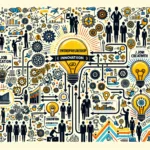Are you preparing for the IELTS Speaking test and wondering how to effectively describe a creative person? Look no further! In this comprehensive guide, we’ll explore expert tips and strategies to help you excel in describing creative individuals during your IELTS Speaking exam. By the end of this article, you’ll be equipped with the knowledge and skills to confidently tackle this topic and impress your examiner.
Understanding the Importance of Creativity in IELTS Speaking
Creativity is a popular topic in IELTS Speaking tests, as it allows examiners to assess candidates’ ability to express complex ideas and use a wide range of vocabulary. Questions about creative individuals can appear in any part of the Speaking test, so it’s crucial to be well-prepared.
 Creative Person IELTS
Creative Person IELTS
Part 1: Introduction and Interview
In Part 1 of the IELTS Speaking test, you may encounter questions related to creativity. Here are some common questions and sample answers:
Q: Do you consider yourself a creative person?
A: I’d say I have my moments of creativity. While I may not be a professional artist or inventor, I often find myself coming up with unique solutions to everyday problems. For instance, I recently repurposed an old ladder into a bookshelf, which I think demonstrates a certain level of creative thinking.
Q: What types of creative activities do you enjoy?
A: I’m particularly drawn to photography and graphic design. I find it incredibly fulfilling to capture moments through my camera lens or to create visually appealing designs on my computer. These activities allow me to express myself artistically and push the boundaries of my imagination.
Part 2: Long Turn (Cue Card)
In Part 2, you may be asked to describe a creative person. Here’s a sample cue card and response:
Cue Card:
Describe a person you know who is very creative.
You should say:
- Who this person is
- How you know them
- What they do that is creative
- And explain why you think they are creative
Sample Answer:
“I’d like to talk about my friend Sarah, who is undoubtedly one of the most creative individuals I’ve ever met. I first encountered Sarah during our university days, where we were both studying graphic design.
What sets Sarah apart is her exceptional ability to think outside the box and come up with innovative solutions to design challenges. She has a knack for combining seemingly unrelated elements to create visually stunning and thought-provoking artwork. For instance, in one of her recent projects, she merged traditional Japanese woodblock printing techniques with modern digital art, resulting in a unique fusion of styles that captivated her audience.
Sarah’s creativity extends beyond her professional work. She’s constantly experimenting with new art forms and pushing the boundaries of her skills. I remember being amazed when she transformed her tiny apartment into an immersive art installation using nothing but recycled materials and clever lighting techniques.
I believe Sarah is so creative because she has an insatiable curiosity about the world around her. She’s always observing, questioning, and seeking inspiration from the most unexpected sources. This, combined with her willingness to take risks and embrace failure as a learning opportunity, allows her to consistently produce work that is both original and inspiring.
In my opinion, Sarah’s creativity is not just about her artistic skills, but also her ability to see possibilities where others might not. Her innovative thinking and passion for exploration make her a truly remarkable creative force.”
Follow-up Questions:
-
Q: How has Sarah’s creativity influenced her career?
A: Sarah’s exceptional creativity has been a driving force in her career. Her unique approach to design has garnered attention from several high-profile clients, leading to exciting opportunities in the advertising industry. She’s now renowned for her ability to create campaigns that are both visually striking and emotionally resonant. -
Q: Do you think creativity is something that can be learned?
A: While I believe some people may have a natural inclination towards creativity, I’m convinced that it’s a skill that can be developed and honed over time. By exposing oneself to diverse experiences, practicing divergent thinking, and cultivating curiosity, anyone can enhance their creative abilities. It’s about training the mind to see connections and possibilities that might not be immediately apparent.
Part 3: Two-way Discussion
In Part 3, the examiner will ask more abstract questions related to the topic. Here are some sample questions and answers:
Q: How important is creativity in the workplace?
A: Creativity in the workplace is increasingly crucial in today’s rapidly evolving business landscape. It fosters innovation, which is essential for companies to stay competitive and adapt to changing market demands. Creative thinking can lead to more efficient processes, novel product ideas, and unique problem-solving approaches. Moreover, a creative work environment tends to boost employee engagement and job satisfaction, as it allows individuals to contribute their ideas and feel valued for their unique perspectives.
Q: Do you think the education system does enough to encourage creativity in children?
A: While there have been improvements, I believe many education systems still have room to better nurture creativity in children. Traditional teaching methods often prioritize standardized testing and rote memorization over creative expression and critical thinking. To truly foster creativity, schools should incorporate more project-based learning, encourage interdisciplinary studies, and provide ample opportunities for students to explore their interests and develop their unique talents. It’s essential to create an environment where curiosity is rewarded, and innovative thinking is celebrated.
Q: How has technology affected creativity in recent years?
A: Technology has had a profound impact on creativity in recent years, acting as both a catalyst and a tool. On one hand, it has democratized access to creative tools and platforms, allowing more people to express themselves artistically and share their work globally. Digital art software, music production apps, and online collaboration tools have expanded the possibilities for creative expression.
On the other hand, the constant connectivity and information overload that comes with technology can sometimes hinder deep, focused thinking necessary for creativity. However, I believe the overall effect has been largely positive, as technology has opened up new avenues for creativity and facilitated the cross-pollination of ideas on a global scale.
Key Vocabulary and Phrases for High Scores
To achieve a high score in your IELTS Speaking test when describing creative individuals, incorporate these advanced vocabulary items and phrases:
-
Innovative /ˈɪnəveɪtɪv/ (adjective): Using new methods or ideas
Example: Her innovative approach to problem-solving sets her apart from her peers. -
Avant-garde /ˌævɒ̃ˈɡɑːd/ (adjective): New and experimental ideas in art, music, or literature
Example: His avant-garde sculptures challenge traditional notions of form and space. -
Trailblazer /ˈtreɪlbleɪzə(r)/ (noun): A person who is the first to do something; an innovator
Example: She’s a true trailblazer in the field of sustainable architecture. -
To think outside the box (idiom): To think creatively and unconventionally
Example: To solve this complex issue, we need to think outside the box. -
Visionary /ˈvɪʒənəri/ (noun/adjective): A person with original ideas about what the future will or could be like
Example: Steve Jobs was a visionary who revolutionized personal computing. -
To push the envelope (idiom): To extend the limits of what is possible or acceptable
Example: Her latest project really pushes the envelope in terms of interactive digital art. -
Groundbreaking /ˈɡraʊndbreɪkɪŋ/ (adjective): Innovative; pioneering
Example: Her groundbreaking research in artificial intelligence has opened up new possibilities in robotics. -
To think on one’s feet (idiom): To think and react quickly and effectively to an unexpected situation
Example: A good improviser needs to be able to think on their feet and adapt to any situation.
Examiner’s Advice
To excel in describing creative individuals during your IELTS Speaking test, consider the following tips:
-
Use specific examples: Don’t just say someone is creative; explain how they demonstrate their creativity.
-
Employ a range of vocabulary: Utilize synonyms and varied expressions to showcase your language proficiency.
-
Speak fluently: Practice describing creative people to improve your fluency on this topic.
-
Show enthusiasm: Demonstrate genuine interest in the creative person you’re describing through your tone and expression.
-
Provide detailed responses: Elaborate on your answers to give the examiner a comprehensive understanding of your thoughts.
-
Connect ideas: Link your responses to broader themes of innovation, problem-solving, and societal impact.
By following these strategies and incorporating the provided vocabulary, you’ll be well-equipped to deliver a high-scoring response when describing creative individuals in your IELTS Speaking test.
For more tips on how to excel in other aspects of the IELTS Speaking test, check out our guides on describing a challenging project and discussing teamwork experiences.


